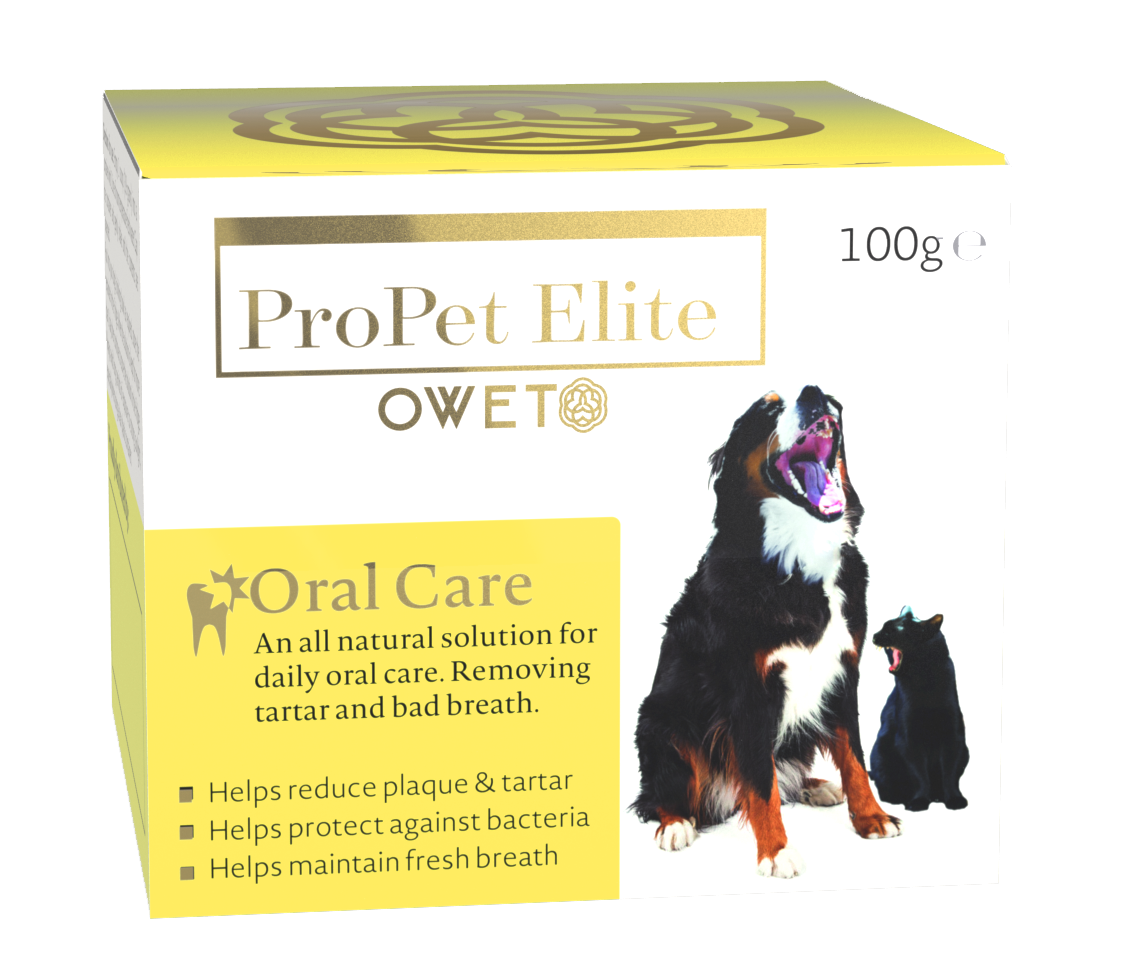Periodontal disease is the most prevalent of all diseases in dogs and cats and a primary cause of health-related ailments (McFadden and Marretta 2013), with up to 80% of pets experiencing gum disease by the age of 3 years. As such, treating the disease is costly, running in the billions of dollars (US) annually on a global scale.
Periodontal disease is typically a slowly progressing disease of the gums, especially along the gingival margins of the teeth, both facially and lingually. Its beginnings are humble, in the biofil that forms over the gums and teeth by bacteria normally found within the mouth (Davis et al. 2014).
Within a few hours the biofilm transforms into plaque which, over a period of days and weeks can completely cover the tooth in a thick, relatively soft plaque. Along the margins of the gum persistent plaque harbours the aggressive bacteria that cause gum inflammation (gingivitis) and directly leads to the irreversible stages of periodontal disease.
The main genera of bacteria that we are interested in are:
Porphyromonas, Fusobacterium, and Capnocytophaga. The species are primarily of gram negative staining. The optimal pH for these bacteria is in the neutral range.
One example is the Porphyromonas known for causing periodontal disease, a serious gum infection that leads to the loosening and eventual, detachment of teeth in both humans and animals.
P. Gulae was found in dogs. This bacterium thrives on periodontal tissues, eating up the gums and reducing well-rooted teeth to shaky cavities.
There are several drinkable oral care products on the market, many of which have zinc gluconate as an antimicrobial and other chemicals (i.e. chlorhexidine) that serve to enhance palatability and freshen breath. Use of some of these products raises their own health concerns. Excess dietary zinc, as may occur from drinking adequate amounts of zinc gluconate containing products, may lead to dietary zinc overload (associated with neutropenia, decreased white cells, sideroblastic anemia, digestive disorders) when used over a prolonged period of time (Olin 1988; Tongesayi et al. 2013; Medici and Grigsby 2013).
Additionally, very few products are supported with published research, raising concerns about veracity of claims and product safety.
Clinical Study
The proprietary OCP was clinically tested in 2 study groups in Canada and the UK was formulated using naturally occurring and beneficial compounds that have been shown to:
• Inhibit the proliferation of orally-occurring bacteria
(Sakanaka et al. 1996; Taylor et al 2005; Kaur et al. 2014)
• Have antioxidant and anti-inflammatory potential
(Hirasawa et al. 2002; Narotzki et al. 2012)
• Have breath freshening and tooth whitening properties
(Kaneko et al. 1993; Blake-Haskins et al. 1997)
It was hypothesized that dogs drinking water into which this OCP was suspended would exhibit a reduced rate of plaque formation, reduced plaque thickness, reduced calculus and an absence of or minimal gingivitis.
On day 0 all teeth were cleaned by a veterinarian and gingivitis was assessed. On return visits on days 14, 21 and 28 plaque index, plaque thickness, gingivitis, freshness of breath and general health were assessed. On average over the 28 days of study, dogs on the OCP had significant reduction in plaque index and plaque thickness.
Up to 60% on average and 37% reduction in plaque formation occurred to canines and first molars during the first two weeks, and there was no gingivitis or calculus at the end of the 28 day study.
This data was produced by consuming the OCP as a normal drinking water additive, and in the absence of other modes of oral care during this process.
Matcha Green Tea
One serving of Matcha tea is the nutritional equivalent of 10 cups of regularly brewed green tea.
When you drink Matcha you ingest the entire leaf and receive 100% of the nutrients of the leaf.
Matcha powdered green tea has 137 times more antioxidants than regularly brewed green tea.
The secret behind matcha’s strength is found in its polyphenol compounds, particularly catechins, a type of antioxidant found in many super foods, but in a much greater concentration in Matcha.
DentalZyme
Dentalzyme was formulated to destroy these specific bacteria at source. Some of the individual active components are as follows:
Lysozyme: Attacks the peptidoglycans which are polymers consisting of sugars and amino acids.
Peroxidase: an important enzyme found in all Dogs saliva.
Catalase: A primary antioxidant functions by catalyzing the decomposition of hydrogen peroxide
Lactoferrin: significant against bacterial and fungicidal activity. It is a globular glycoprotein.
Ingredients
Matcha green tea
DentalZyme – selected enzymes
Sodium bicarbonate
Cultured dextrose
Ascorbic Acid
Serving Suggestions
Mix with 1 litre of fresh water or apply powder directly to feed.
Zusätzliche Information
| Size | 50g, 100g |
|---|
Switzerland
Herr Dr. Christoph Jäggin — click here
Dr. Frank Schellenberger — click here
Netherlands
Tops Vastgoed B.V.Edwina Tops-Alexander
Germany
Tierklinik Lüsche — click here
Herr Dr. Immo Müller
Klinik für PferdeDr. Jürgen Fischer
Tierärztliche Praxis für PferdeDr. Martin Hinrichsen
Verwaltungs- und HandelsgesellschaftDr. W. Jahn und Dr. V. Sill
Herr Dr. Marc FeldmannTierarztpraxis
Tierarztpraxis für PferdeHerr Dr. Bernhard Ekrod
Tierärztliche Praxis LichtenmoorDr. Veronika Sinz
Pferdeklinik Ankum GmbH
Frau Dr. Anja von DiekenTierarztpraxis
Herrn Dr.Matthias Meyer-Wilmes
Equivet VerlCarsten Dicks
Tierärztliche Hausapotheke
Pferdeklinik Duisburg GmbH Dr. Kathrin Rasch & Dr. Michael Novak
Frau Dr. Paticia ZweverinkPraktische Tierärztin
Dr. Joachim PietrowskiTierärztliche Praxis
Tierarztpraxis Kolberg Herrn Christian Kolberg
KALDENHOFF & VAN ‚T RIET GbR Apotheke
Herr Dr. Heribert Schürholz
Pferdeklinik Burg Müggenhausen — click here
Frau Dr. Agne Subaciute
Tierarztpraxis am Ravelsberg Dr. med. vet. Thomas Westenberger
Frau Dr. Ulrike Munnes-JugertTierarztpraxis
PraxisgemeinschaftDres. Michael Frevel & Gregor Heinekamp
Praxis für Pferde Michael Saxerprakt. Tierarzt
Firma TBW ApothekengesellschaftDr. Kai Kreling
Tierarztpraxis Gerhold GbR
TierarzneimittelDr. Norbert Beer
Frau Dr. Ulrike Häusler-Naumburger
Herr Dr. Wolfgang Krauss
Herr Dr. Norbert Wolff
Frau Dr. Marie Lindinger
Arzneimittelabgabe GbRDr. Adolphsen,Dr. Brems,E. Göschl,Dr. Wagner
Pferdeklinik am KirchbergDr. med. vet. Uwe Heidbrink
Tierklinik Dr. W. Doering

